The lacquered surface on anything you hold in your hands gives a pleasant feeling of smoothness, fidelity, and perfectness that we all seek in this uncertain life. Did you know that people started to decorate their housewares with lacquer centuries ago? But instead of using synthetic substances, only natural materials, along with meticulous polishing techniques, were used for making perfect surfaces. In fact – lacquer was one of the first kinds of plastics people used in their homes!
The English word “lacquer” is believed to come from “lakh” in Hindi, which derives from Sanskrit “lākshā,” also consonant with Latin word “lacca” (resinous substance) and the Arabic word “lakk.”
Lacquers and lacquering techniques are known to have been originated in China in the 2nd millennium B.C. Ancient Chinese artisans started to use the sap of the lacquer tree (highly toxic, by the way) as the material for lacquering trinket boxes, vases, furniture, bowls, and architectural details.
Lacquered wooden boxes with painted and incised decorations made in China in the 2nd-1st century B.C. are one of the earliest instances of ancient lacquer art masterpieces that are saved nowadays in public museums or private collections.
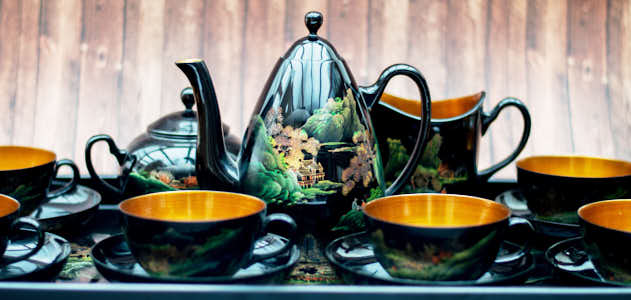
At that time, elements made of wood, papier mache, cloth, or porcelain were treated for long-time operations of priming, applying several coats of lacquer (up to 30 layers), drying, carving and polishing to achieve the required levels of durability and water-resistance of an item.
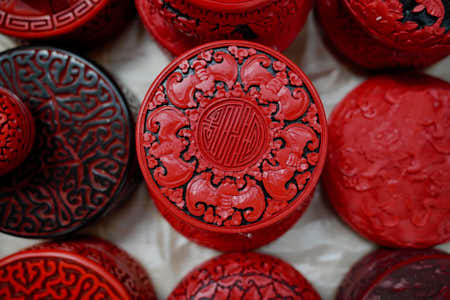
Over centuries, Chinese artisans gradually developed several decorating techniques where the lacquer playing a significant role in decoration and preserving the decorated surface. After the 10th century D.C. the following significant methods of using lacquer were formed in China:
- “Engraved gold technique” when golden foil or powder was applied in cavities of the prepared wooden surface and then covered with lacquer;
- filled-in lacquer – a method of application of lacquer of different colors in the way of a combination of layers and their further revealing by polishing of combination of lacquered areas in the form of carving the hardened lacquer and inlaying lumps of other colors;
- carved lacquer – when the decoration is carved out of dry lacquer mass (usually of red color) applied in multiple thin coats on an item; this technique is considered to be an original achievement of ancient Chinese masters;
- inlaying lacquer with mother-of-pearl, tin or silver;
- the most beautiful painting is with polychrome and golden lacquers (with golden powder additive) on black or color background.
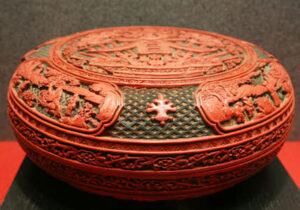
Landscapes, flowers, animals (real and unreal – mostly dragons), and life scenes were the main topics of lacquer art by ancient Chinese masters. While the lacquering procedure was very labor-consuming, a lacquered item at that time did not mean the sign of luxury. Lacquered finishing extended the term of service of a houseware in a wet tropical climate and, therefore, was gradually spread. However, as a rule, artisans tried not to disclose the secrets of their technologies. But, with time, let alone the precaution measures, these secrets leaked to other countries of South-Eastern Asia, simultaneously with the spread of Buddhism. Military conflicts of China with neighboring Korea and Japan, as well as trading contacts, were also the related factors of spreading the Chinese lacquering technologies into these countries.
Lacquer in Korea
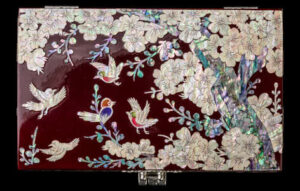
The first lacquer decorated items appeared in Korea after the country was conquered by the Chinese Khan Empire (108 year B.C.). After that, Korean culture was subjected to the Chinese impact for a lot of centuries. The technique of decorating lacquer surfaces with metal foil inlay was one of the primary Chinese influence. However, with time, Korean artisans developed their decorative method of mother-of-pearl inlay decor, which became dominant for many centuries throughout the present days.
Lacquer in Japan
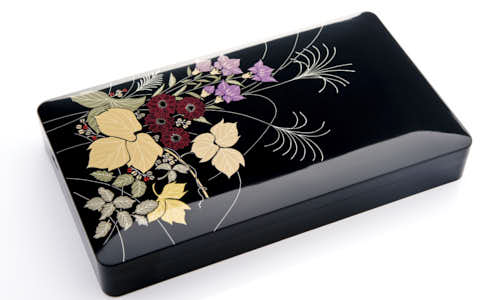
The first lacquered art items brought to Japan were made in China in the VI century A.D., and at about this time (VI-VII century A.D.), the lacquer production technology was brought to Japan from China through Korea. Artisans from those countries were voluntarily or forcibly relocated to Japan, facilitating the development of lacquer art. According to a legend, the lacquer tree was also imported to Japan together with introducing the technology. At that time, lacquer was used for decoration of the most important state constructions. It became very popular to encrust the lacquered art products with corals, nacre, gems.
In the year 794, the capital of Japan was moved to the city named Heian-kyō (modern name – Kyoto), which served as the reason for decoration of the new Emperor’s Palace where the latest technology of lacquering with golden lacquer was widely used. This technique (named “makie”) is a process when a golden and silver powder is applied on a layer of lacquer, which then is covered with a finishing thin lacquer layer. Namely, this technology is different from the Chinese craftsmen’s methods became later a distinctive feature of the lacquer art of Japan.
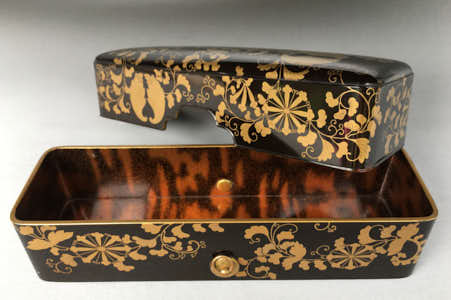
Another original Japanese technique of lacquer decoration was drawing a picture on a layer of lacquer when it was still wet. After the application of the next coat of lacquer and its drying, all of the surfaces are polished with charcoal to display the volumetric pattern created in this way.
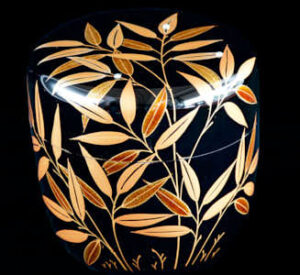
Later on, the lacquer industry of Japan became so widely spread that in approximately the year 905, a law was passed which regulated the content and the materials of the lacquer compositions made on the territory of Japan of that time.
In 1543, Portuguese merchants arrived in Japan, followed by Dutch in 1600, and the exotic and highly expensive lacquerware from Japan conquered the consciousness of European aristocrats, becoming the new attribute of luxury at that time. This started the new era of lacquer in Europe.
Lacquerware in Europe
Asian lacquers became known in Europe from the XV century with the flow of lacquered furniture and decorative accessories from Asia, mostly from China and Japan. Later on, in the early 1700s, many European elite houses and palaces considered owning Asian lacquerware as a “must-have” to prove their high position in society. Import of Asian lacquerware was growing fast and many of Chinese and Japanese manufacturers oriented the plots of their decorations on European customers. Seeing the demand for lacquerware from Asia, European merchants even started to send unfinished pieces of furniture and other items to China and Japan for final decoration and lacquering. At the same time, in 17-18 century European craftsmen started their own production of lacquered items (decoration of interiors in the palaces of nobility, furniture and houseware). European craftsmen simplified the lacquering technique by introducing hot drying, using oil paints and oil varnishes. In 17th century the manufactures of Marten brothers in France and Johann Stobwasser in Germany were standing out as makers of painted and lacquered items such as decorative boxes, cigarette cases and snuffboxes garnished with miniature paintings.
Iconic European manufacturers as well as other craftsmen from England, France, the Netherlands, Portugal and Spain started to imitate Asian lacquer work which became popular in Europe in the 17th century. This technique used finishes that have a resin base similar to shellac and was called “japanning.” It involved applying several coats of varnish, which were each heat-dried and polished. In the 18th century, the popularity of japanning grew, and more and more European houseware manufactures used this technique in their production.
It is worth mentioning that along with the classical plots of paintings, such as portraits of beautiful women, landscapes, or still life, European manufacturers also portrayed warlords, members of European royal families, and even erotic scenes on their lacquer boxes.
Lacquerware in USA
Lacquerware made in China was very popular in the U.S. in the 17th-18th century. Americans highly appreciated jewelry and sewing boxes, musical instruments, umbrellas, furniture pieces and other items as well as other quality goods from China in a row with vintage Chinese export goods like porcelain, tea, and silk.
Russian lacquerware
Starting from the 18th century, being a part of European culture transition, production of lacquerware started in Russia.
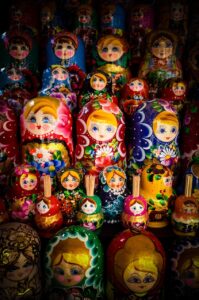
Lacquerware was made of wood (palace interiors decoration, furniture), paper-mache (lacquer boxes and snuff boxes), metal (trays), which were hand-painted with portraits, landscapes, flowers, genre scenes using oil paints. It is considered that the Russian art of lacquer painting grew from the art of Orthodox Christian icons painting. With the development of industrial production in Tsar’s Russia at that time and increase of financially wealthy entrepreneurs who wanted to have the same lacquered “toys” as Russian aristocrats had, but at more reasonable prices, icon masters shifted to the production of lacquer miniatures decoration.
One such “new Russian” merchant of that time was Piotr Korobov, who had managed to visit the Stobwasser manufacture, which, as we mentioned earlier, was the leading producer of lacquer boxes in Germany. Korobov could lure several German craftsmen from Stobwasser and started his own manufacture in Russia on the edge of 18th and 19th centuries.
Later on, at the beginning of 19th century individual manufacturers were united in so-called “folk crafts” – when several artisans located on a specific locality and decorated products in a particular style or pattern. The name of such location became the name of the decoration style used by these Russian Folk Crafts. Later, the name of the decoration style transitioned to the name of “decoration school.” There are several Russian decoration schools consonant with the name of villages they originated from. With Russian lacquerware, we define the most famous lacquer decoration centers, such as Fedoskino, Palekh, Kholuy, Mstera. Every village has its style of painting. The oldest and most famous Russian lacquer art center is, of course, Fedoskino village, located only 40 km from Moscow, the other three are located in the Ivanovo region of Russia and requires several hours driving from Moscow.
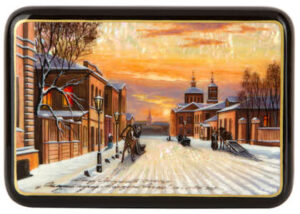
Classic black Russian lacquer boxes made in the localities mentioned above are crafted using paper mache as the basis of the box. This is multi-layered pressed cardboard impregnated with linseed oil, from which, as a result of many operations, caskets, boxes, chests, and other items are assembled. The assembled form is then processed, putty, dried, polished, and only then covered with black lacquer in several layers. Inside, the product is painted in red and coated with colorless varnish.
Russian lacquer artists paint art miniatures on the box using the multi-layer painting technique with color oil paints. For decoration of the lacquer boxes with the higher price ticket, mother of pearl and gold leaf lining are used. In such kinds of boxes, the mother of pearl is integrated on the cover of the lacquer box, and painting is done on it. Then the artwork is finished; the whole box is polished and covered with finishing layers of lacquer. Modern lacquer boxes in Russia are also done on white, cream white, light blue, brown, golden, and other colors of the box exterior.
Lacquerware in Ukraine
Being located in the center of geographical Europe and bordered with Russia in north-east Ukraine was a vital center of East Slavic culture with the powerful state of Kievan Rus, which formed the basis of Ukrainian identity. These Slavic roots determined the birth of the Ukrainian decorative painting style named Petrykivka, which was born originally in the village of Petrykivka in the Dnepr region of Ukraine.
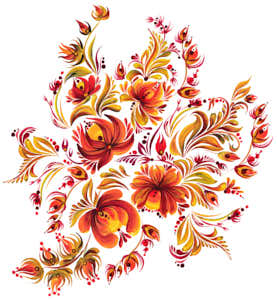
Petrykivka is a plentitude of plant ornaments of bizarre forms, particularly flowers with elements of a fantasy fauna (pictures of firebirds, phoenix, or roosters).
Traditionally used to decorate house walls and everyday household items of peasant Ukrainians, Petrykivka manner of painting with years became the Ukrainian “brand” of popular culture recognized worldwide. In 2013 the United Nations Organization remarked Petrykivka art technique by including it to the UNESCO Representative List of the Intangible Cultural Heritage of Humanity in 2013.
Today, Petrykivka can often be found not only in the interior or houseware but also on clothes, cars, and even in tattoos.
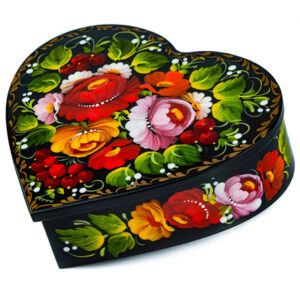
Petrykivka ornament is the primary pattern presently used by modern artisans for decoration of lacquer boxes made of wood and other wooden houseware made in Ukraine. There is a small modification of Petrykivka, named “Kyiv Painting,” which is more perfected and more complicated than Petrykivka. Its main feature is the sparkling saturated floral painting on a deep black surface, perfectly lacquered. This manner allows artists to show all the vividness of their mastery. Their mastery lies in extraordinary agility of their hands: no preliminarily set contours or measuring tools. Cornflowers and chamomiles, roses, and dahlias bloom under a magic brush of folk artisans and intertwine into one magic bouquet that will never fade.
Here you can find several kinds of lacquerware hand-painted in Petrykivka Kyiv painting manner: lacquer jewelry boxes of several forms and sizes, Easter eggs, decorative wooden bells, hand-painted cosmetic mirrors and toothpick holders.
